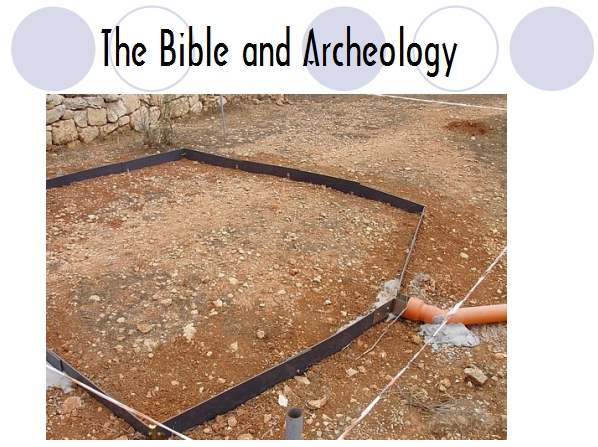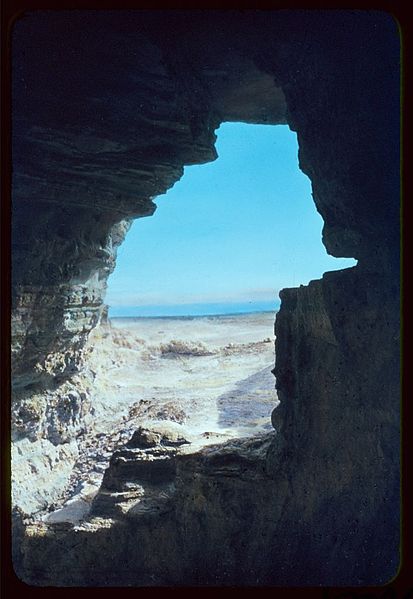|
DPS Biblical
Archeology Study Outline
1. Introduction
|

Download: Teacher's Script: (PDF)
(Word) |
Handout: (PDF) (Word) |
PowerPoint
Overview
a.
The Bible and Archeology
b.
Archeological tools
c.
Significant confirmed biblical
structures
Discussion Questions
a. The Bible and Archeology
Why So Much Importance Is Attached To Biblical Archeology
 Of all the religions and faiths in the world, the Judeo-Christian
faith is somewhat unique in its historical component. While all the
other religions and faiths "contain" histories, our faith seems to be
"based" on history. If the historical content of most other faiths is
removed, their basic philosophy or substance is not affected. But this
is difficult to do with the bible, as it makes definite historic
claims. Remove the historical content, and the Christian faith [and the
Jewish faith] is seriously challenged. That’s why biblical archeology is
important. Of all the religions and faiths in the world, the Judeo-Christian
faith is somewhat unique in its historical component. While all the
other religions and faiths "contain" histories, our faith seems to be
"based" on history. If the historical content of most other faiths is
removed, their basic philosophy or substance is not affected. But this
is difficult to do with the bible, as it makes definite historic
claims. Remove the historical content, and the Christian faith [and the
Jewish faith] is seriously challenged. That’s why biblical archeology is
important.
Benefits of Biblical
Archeology
1- Insights Into History/Chronology: Most people do not realize that
the way history is written, and the way in which chronologies are
constructed, vary from culture to culture. Thus the historical and
chronological records produced by people of one culture can be
understood only if we understand the presuppositions and methodologies
of those people.
2- Insights Into Culture/Customs/Manners: Culture, customs, and
manners vary from place to place and time to time even within a single
country. So much so that what is considered as appropriate and even
desirable behavior in one part of a country can be interpreted as
undesirable in another part of the same country. Since that is the case,
the Biblical history covering a span of 4000 years, having taken place
in dozens of countries, contains many things related to these things
that might perplex people today. Some of the Biblical statements can
even be misinterpreted today.
3- Insights Into Languages/Meanings:
Biblical languages are dead today. They are not spoken anywhere. Thus it
is difficult for the twentieth century reader to understand all the
finer nuances of these languages when they were used by people for whom
it was their native language. Historical investigations, however, have
produced tens of thousands of writings of all kinds in these languages,
enabling linguists to understand vocabulary, word usage, and idioms of
these languages more accurately.
b. Archeological Tools
Archaeological field survey is the methodological process
by which archaeologists (often landscape archaeologists) collect
information about the location, distribution and organization of past
human cultures across a large area.
Surveys:
In a non-intrusive survey,
nothing is touched, just recorded. An intrusive survey can mean
different things. In some cases, all artifacts of archaeological value
are collected. This is often the case if it is a rescue survey, but less
common in a regular survey.
Another form of intrusive
research is bore holes. Small holes are drilled into the ground, most
often with hand-powered bores. The contents are examined to determine
the depths at which one might find cultural layers, and where one might
expect to strike virgin soil.
Geophysical survey is used for subsurface mapping of
archaeological sites. In recent years, there have been great advances in
this field, and it is becoming an increasingly useful and cost-effective
tool in archaeology. Geophysical instruments can detect buried
archaeological features when their electrical or magnetic properties
contrast measurably with their surroundings. In some cases individual
artifacts, especially metal, may be detected as well.
Analysis
The analysis is the most important phase in archeology;
it includes careful examination of all the evidence collected. A method
often used to determine its value is to compare it to sites of the same
period.
Dating Methods:
An artifact, an inscription, or a mummy can be placed in
historical context and interpreted only if one can speak with some
certainty about what period it belongs to. The closer an object is to an
event, the better one can interpret the event or the object, and the
farther it is the less its relation to the given event. A cult object
found from the home-town of Abraham, but used only two millennia after
the time of the Patriarch, would throw less specific light on his life
and more on the culture millennia after him.
Finding the collapsed walls of ancient Jericho is
exciting. But this discovery is useless for Biblical archeology unless
it can be demonstrated that this even happened within the dates
specified by the Biblical historian. If someone can definitely establish
that the discovered event happened 500 years before or after the dates
demanded by the Bible, it automatically becomes useless for a possible
correlation with the conquest mentioned in the Bible.
Pottery Dating: As a result of
decades of careful work on pottery, correlated with absolute
chronologies, helped by discoveries of modern science of dating, and
compared with neighboring countries, Pottery-based Dating has become an
important component of dating in Biblical lands.
Other major
Relative and Absolute methods of dating used in archeology are as
follows:
Relative
Dating Techniques
·
Cultural Affiliation
·
Fluorine Dating
·
Patination
·
Pollen Analysis
·
Rate Of Accumulation
Absolute
Dating Techniques
·
Archeomagnetism
·
Astronomical Dating
·
Dendrochronology
·
Electron Spin Resonance
·
Fission Track
·
Opacity Stimulation Luminescence
·
Oxidizable Carbon Ratio
·
Racemization
·
Thermoluminiscence
·
Radio-Carbon Dating
c. Some
Significant Confirmed Biblical Structures:
·
Gibeon pool (at el-Jib)
·
Hezekiah’s tunnel under Jerusalem
·
Jericho’s walls. John Garstang in the 1930s dated Jericho’s destruction
to around 1400 BC.
·
Lachish siege ramp of Sennacherib
·
Pool of Siloam (unearthed in 2004)
·
Second Temple pre-Herodian Walls. The outline of the walls of the square
platform that predates the Herodian expansion and, therefore, dates
either form the reconstruction in the Persian period under Ezra and
Nehemiah or is a survival of the pre-exilic first Temple have been
located on the surface of the present platform. The northwestern corner
was visible (until it was concealed recently) as the lowest
step in a flight of stairs that parallels the eastern wall of the Mount,
the north eastern corner as a protruding stone, the south eastern corner
as a slight alteration in the angel of the eastern wall where the older
platform joins the Herodian expansion. The courses of stone that form
the center of the eastern wall are also pre-Herodian, and match the
stone masonry of the north west corner of the original platform, now a
concealed bottom step.
·
Second Temple (confirmed by Western/Wailing wall constructed by Herod
the Great)
·
Shechem temple (spanning the late Bronze Age to the early Iron Age)
corresponding to the "House of (the god) Baalberith" in Judges 9
·
19 tumuli located west of Jerusalem, undoubtedly dating to the Judean
monarchy, but possibly representing sites of memorial ceremonies for the
kings as mentioned in 2 Chronicles 16:14, 21:19, 32:33, and the book of
Jeremiah 34:5
·
Gezer Walls and City Gate. Verification of the site comes from Hebrew
inscriptions found engraved on rocks, several hundred meters from the
tel. These inscriptions from the 1st century BCE read "boundary of Gezer."
·
[Nehemiah]‘s wall.
Discussion Questions:
1.
Could Christianity/Judaism be a valid religion if the historical
accounts turned out to be mere sacred stories? What if some accounts
turned out to be historical and others not?
2.
Biblical archeology uses scientific methods and theory; do you see a
conflict in relying on science when it comes to faith issues? Should
faith and science not be separated?
|